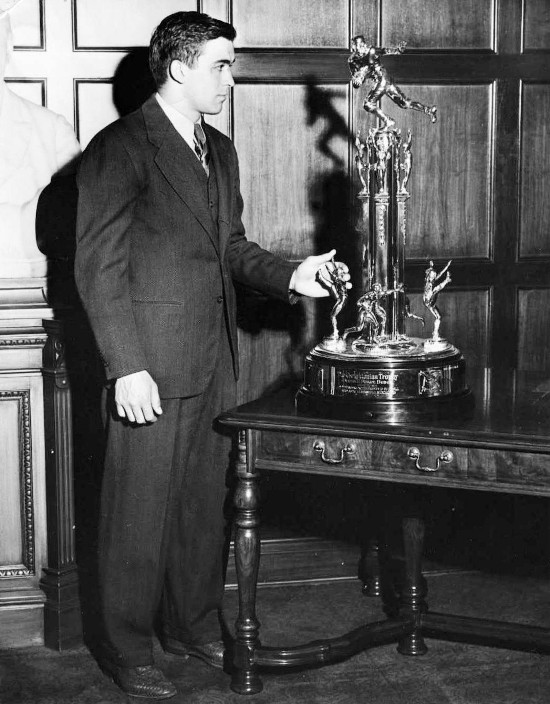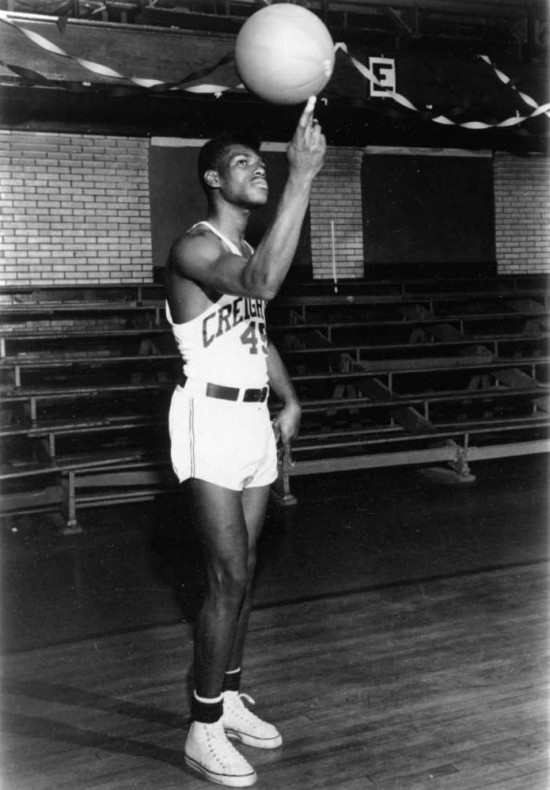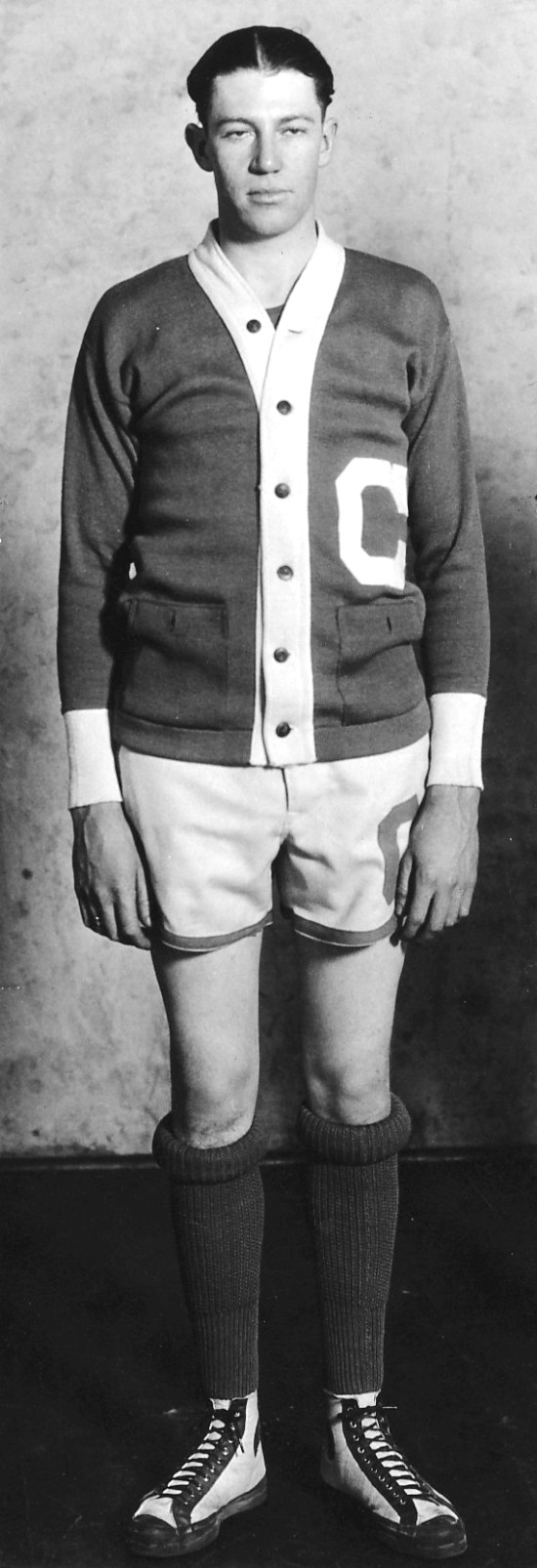If you’re reading what we write here at White & Blue Review, then you’re most likely a die-hard Creighton sports fan. And, the chances are great that you’ve got some fellow CU fans that need thoughtful gifts this holiday season.
One gift I received last Christmas is Creighton University Athletics: A History in Photographs, a historical tome written and compiled by CU alum Travis Sing. The book documents, via beautiful photos and detailed captions, the long and distinguished history of Creighton’s various athletic programs.
Yes, even football.
I caught up with Sing to talk about his motivation for the book, some of his favorite aspects of pulling everything together, and whether or not Creighton used to have women’s rifle team.
This book makes a great stocking stuffer … more info below about where you can buy it for that Jays fan in your life!
NOTE: There are some great black and white images embedded in this post, courtesy of Sing. Enjoy!
White & Blue Review: What was your inspiration for publishing this amalgamation of Creighton’s athletic history? You graduated from Creighton with a degree in history; were you a sports fan while at CU? How closely do you follow Creighton sports today?
Travis Sing: There were several factors that led to this publication. My primary inspiration was to demonstrate the athletic tradition of my alma mater. I was seeing new books on Nebraska football every year. I thought, “Creighton needs and deserves a book about its athletic tradition.” When I worked in Brunswick, ME, I was the site manager for the Skolfield-Whittier House. One of the home’s occupants, Dr. Frank Nathaniel Whittier, was a professor at Bowdoin College. Whittier was highly involved with that institution’s athletics program in the late 1880s/early 1900s. It soon struck me that I knew far more about Bowdoin College’s history (athletically and otherwise) than I did Creighton’s.
I had initially envisioned a photographic history of Creighton, but the university issued the superb The History Of Creighton University, 1878-2003, authored by Dr. Dennis Mihelich, so I narrowed my focus to athletics. Creighton athletics have never been more popular as they are now, and I thought the time was right for a publication of this nature.
My uncle, Dr. Michael G. Farrall, was a Sociology professor at Creighton, and he got me hooked on Creighton soccer immediately after I arrived on campus in the fall of 1991. I was in pep band (alto saxophone) my freshman and sophomore years, so I attended all home basketball games. After I stopped playing in the pep band, I infrequently attended basketball games.
I’m a fairly casual sports fan in general, but I try to keep up with how things are going on campus. My wife and I are season-ticket holders for men’s basketball, and I try to attend quite a few men’s soccer matches. On occasion I’ve been to baseball games, and now I realize I need to attend more women’s events.
WBR: Did researching, writing, and publishing this book give you a different perspective when you watch and follow Creighton sports now, compared to in the past?
TS: It certainly did give me a different perspective, because now I know how and when the traditions began. I knew only a few things about the school’s athletic past: Bob Gibson, Paul Silas, and even a bit about Connie Yori. Unlike many my age, I had actually heard of football player “Slingshot” Johnny Knolla because I knew his granddaughter at Creighton.
Overall, I knew little about what these gentlemen, and ladies, actually accomplished while at Creighton and beyond. With men’s basketball, for example, many of my generation think that Tony Barone or Dana Altman put Bluejays basketball on the map. But Arthur A. Schabinger and Eddie Hickey were the coaches who did that from the 1920-40s.

"Slingshot" Johnny Knolla led college football in total offense in 1940
WBR: All told, how long did it take you to put this book together? How was this project a natural extension of your career in preservation, education, and historic site management?
TS: All told, it took about a year and a half for research, collecting and scanning photos, writing, and layout. I wanted to take my time and make sure I had covered all of the bases (sports pun intended).
I’m an independent historian, so researching and writing is what I do. I worked at Making History here in Omaha while in graduate school at UNO. Making History was an historical consulting firm headed by Dr. Martha Webb. We published a few books, but mostly worked on museum exhibits. It was a fantastic learning experience for me, and I started to think of history more in public terms rather than just in academic terms. Public history still adheres to the same rigorous research methods, but the presentation is for a more general audience. My first book was Omaha’s Easter Tornado of 1913 (Arcadia Publishing, 2003) for their “Images of America” series, which are books of photographs accompanied by text. I utilized the same format for the Creighton athletics book.
WBR: The book if full of wonderful information and great photos, cover to cover. What are a few of the things you found or you learned while writing this book that left you shaking your head in amazement?
TS: Thank you for saying that. On occasion I worried I had included too much information about some items. While at other times, I just couldn’t find a photo or any information to illustrate a certain person or point. But that’s the nature of historical research. Fortunately I usually had a wealth of information at my disposal. Okay, now on to your question…
There were several items that amazed me. Researching the football program was fascinating because it had been lost to several generations of Bluejays. Basketball player Willard Schmidt’s participation in the 1936 Olympics earned him a gold-medal with the first U.S. Olympic basketball team. Schabinger was not only a highly successful basketball coach, but he helped codify and shape the game beyond Dr. James Naismith’s original conception. “Slingshot” Knolla put up amazing numbers on the gridiron in 1940, leading the nation in total offense, yet was barely an All-American selection. I was surprised to find Bill Fitch, the former NBA coach, was a successful baseball coach during his short tenure at Creighton. I cannot fathom how anyone could not be in awe of Albert Brown, who is now a centenarian, and a Bataan Death March survivor. (Brown is supposedly the university’s oldest living alumnus, and the oldest March survivor. I think he’s now 103.)
As far as amazing athletic achievements there were many, but one that stands out is Paul Silas averaging over 20 points and 20 rebounds per game all three years he played varsity. My vote for the singular, most amazing athletic feat in CU history goes to softballer Kelly Brookhart for pitching a complete 31-inning game in 1991. Let me state that again: a complete 31-inning game! Then, she followed that up by working more than 20 innings in the next game on the same “day” (that night game went 25 innings until 6 the following morning). That’s positively superhuman!

Willard Schmidt won a gold medal in the 1936 Olympics
WBR: Can you explain what it was like to work with David Crawford, Creighton’s Archivist? What are the archives like?
TS: David and I worked together at Making History, so our relationship goes back over a decade. He is intelligent and a genuinely nice fellow. If he ran across something he thought I could use for the book he would set it aside for me. David and the archives student workers/interns couldn’t have been nicer to me. I was thrilled when I heard that David was offered the job as the first truly professional archivist at Creighton.
The archives are housed in a giant room in the basement of Reinert-Alumni Memorial Library, and David has a nearby office. It was a thrill to “discover” items in the archives. The photo I found of Bob Gibson spinning a basketball on his finger was passed to Rob Anderson in the Sports Information Office. (Rob also was very kind in letting me use their resources, I should point out.) Rob then passed it on to ESPN, who used it on air during the 2008 Creighton-Southern Illinois basketball game.
I still go to the archives once in a while to continue trying to identify athletics photos that have no accompanying information. David had a tall task in front of him when he accepted the position, and he has done a wonderful job of making the archives more usable, and promoting the archives as an invaluable source of institutional history.

Bob Gibson excelled on the hardwood before becoming a HOF baseball player
WBR: You saw quite a few interesting jersey styles and fashion statements while putting the book together, I’m sure. If you had to choose a uniform from Creighton’s past that you’d like to see used as a “throwback” for a current Bluejays team, what would it be?
TS: I really like the gothic letter “C” on the track team uniforms of the 20s. Could the cross country teams revive that? One that I found most odd is probably the basketball uniforms/warm-ups in 1910s-early 20s: a cardigan sweater and knee-high socks with a big roll just below the knee. Check out the photo of Jimmy Lovely for this look.

Check out the "Lovely" rolled socks-and-sweater uniform!
WBR: The Creighton Icebirds? Seriously?! I think people would be surprised to know CU had a hockey team; what other smaller sports programs did you find intriguing while researching the book?
TS: Definitely the rifle team, and the information about it was spotty. I did come across a column from the Creightonian in October 1929 that mentioned the formation of a girls’ rifle team. The author suggested that all the guys on campus “had better be careful.”
(Looking to buy Creighton University Athletics: A History in Photographs? You can purchase signed copies directly from Osage Orange Publishing (via this link). Or, if you’re in Omaha, you can find it at local retailers such as the Creighton University Bookstore, The Bookworm (in Countryside Village), and Border’s Books and Music.)
